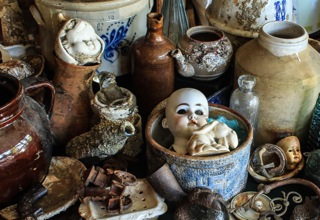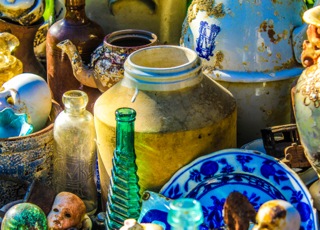“It is the hunt that makes me do it,” says Richard (Rick) Carney Jr. of Brunswick, Maine. “Anywhere there were people, there is stuff.” Carney is referring to the thousands of old bottles, crockery items, coins, rings, and clay pipes that he digs, dives for, and collects.
Carney’s interest in old bottles began when he was twelve, and his mother had a yard sale from bottles she had dug up. After that, Rick was hooked.
Early on in his thirty years as a scuba diver, he purchased underwater metal detecting equipment. Then, soon after, he went treasure diving and found a class ring in twelve feet of water at Camp Fernwood on Thompson Lake in West Poland, Maine.
Carney tracked down the owner, using initials engraved on the band. Beverly Winslow Parker, class of 1944 at Saugus High School in Saugus, Massachusetts, was speechless when in September of 1994, she answered the phone and learned her long lost ring had been found.
From Trash To Treasure
From long lost bottle fragments of the deep, Carney creates a line of jewelry, which he markets through his company Old Bottle Sea Glass of Maine. He also works in the art world, mostly in stained glass. Carney produces one-of-a-kind window panels and functional art lampshades using his found bottle glass and artifacts.
Sometimes Carney’s artifacts and one-of-a-kind items can be found in the most unexpected places. One October, Carney and his wife Cindy had a booth at Apple Harvest Day in Dover, New Hampshire. While taking a break from selling his wares, Rick wandered over to the nearby Cocheco River. Then, he returned the next week with his gear and went into the water. Right in front of him was a flawless four-gallon crock made in Bennington, Vermont, with a big blue flower painted on the side!
Later, diving in a river in Hudson, Massachusetts, he was amazed to find a perfect glass gasoline pump globe with the words “THAT GOOD GULF GASOLINE” still visible. That glass globe used to light up on top of Gulf gas pumps at service stations back in the 1930s and ’40s. It now could be worth anywhere up to $400!
“I was the first person in 150 years to go into Wiscasset Harbor,” says Carney in wonder. He started bringing up perfect bottles from the 1760s to the 1790s, and big, colorful chunks of glass untouched since the 1850s.
Carney’s workshop is filled with brown English rum bottles and eagle flasks that will go into lampshades and panels. Tiny olive morphine bottles and Carter’s aqua ink bottles line a printers’ composition drawer hanging on one wall. The workshop has spilled into the basement and bottles of all types line the shelves.
Preparing for an art exhibit, Carney was embedding an old ceramic doll’s head in a small amber demi-john bottle. He titled the piece “Preserved in Amber” and hopes it will one day hang in a lucky customer’s window.
More Than Just Digging For Treasure
Carney considers the Piscataqua River at Portsmouth, New Hampshire, the most dangerous river to dive, with its tides, swift currents, and poor visibility. There is always an 8 to 10-knot current, so he rigs himself a search line from an anchor. “Navigating underwater is like navigating blind,” he says. “Always trust the equipment. You can’t see anything, you’re feeling around for stuff.”
Carney goes treasure diving all year, most of the time by himself. “Winter is my favorite time,” he says, “No boats, no people, and I know my comfort zone.” But as Carney emphasizes, diving is inherently dangerous, especially in winter. One wrong move and a diver could end up under the ice.
On a dive near the Essex Steamboat Museum, he was diving around pilings. As he came up to check on his friend, their regulators froze up. The air was 40 degrees F, but the water was 34 F. So, that was the end of diving for that day.
Also, “It’s a whole different ballgame diving in a dry suit, “says Carney, who wears this heavier outfit with extra weights from December until May. He switches to a 7-millimeter weight wet suit in late spring and 3-millimeter suit for summer.
“I don’t take chances. If the hair suddenly stands up on the back of my neck, I get out of there.” He mostly dives alone because others don’t want to take the time. However, visibility is often reduced due to current. So, the torpedoes he uses to propel himself often do double duty, blasting holes in the river and ocean bottoms to reveal treasures.
Digging Up History
Even so, Carney may have succeeded at every man’s dream of turning an exciting hobby into a life’s work. “The trash is everywhere. I don’t look at it that way, but in 1850, whoever threw out that jug said, ‘this is garbage’.” He does lots of research about wrecks and dumpsites, pouring over old maps and records to get background information.
He has brought up lots of 1790s bottles, dishes, pottery, and clay pipes down in Phippsburg, Maine, on the Kennebec River. Phippsburg dumped the town trash there near Parker Head Steamboat Landing for 200 years.
He also digs old land dumps and privy sites. Before the advent of indoor bathrooms, people tossed trash into the outdoor privy during winter when they could not get out to the burn pile. After 100 years, all that is left is metal and glass.
Carney is radiant as he describes a massive find in 2004, while treasure diving in the Presumpscot River in downtown Westbrook, Maine. On this summer dive, he discovered a solid wall 40 yards long of bottles, glass, crockery, dishes, and other items that banked the curve of the river.
What was his most valuable find to date? In December 2008, he brought up an old amber-colored Farley’s ink bottle worth $800. At this dive, he dove with a buddy, who brought up another Farley bottle in a rare green shade. Value? “Thousands of dollars. Thousands!”.
Who knows what other treasure is lurking beneath the depths?
Visit Carney’s website, Old Bottle Sea Glass of Maine, for further tales of his memorable finds.
Would you go treasure diving? Alternatively, what are some artifacts you’ve found lurking in the seas? Let us know in the comments below!
Article updated June 2, 2020
Read Next:
Kayaking Maine’s Orr’s & Bailey Islands
4 Great Ways To Get Into The Charles
SUP & The Totally Unexpected: Close Encounters With Creatures Of The Deep







Follow us for the latest news!